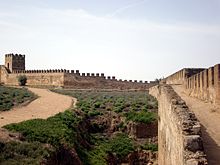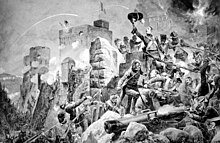Badajoz
Badajoz | |
|---|---|
City | |
 La Giralda and the Fine Arts Museum. | |
| Country | |
| Autonomous Community | |
| Province | Badajoz |
| Comarca | Tierra de Badajoz |
| Founded | 875 |
| Founded by | Ibn Marwan |
| Government | |
| • Mayor | Miguel Celdrán (PP) |
| Area | |
| • Total | 1,470 km2 (570 sq mi) |
| Elevation (AMSL) | 185 m (607 ft) |
| Population (2012) | |
| • Total | 152,270 |
| • Rank | 302 |
| • Density | 100/km2 (270/sq mi) |
| Time zone | UTC+1 (CET) |
| • Summer (DST) | UTC+2 (CEST (GMT +2)) |
| Postal code | 70862 |
| Area code | +34 (Spain) + 924 (Badajoz) |
| Website | Official website |
Badajoz (Spanish pronunciation: [baðaˈxoθ], formerly written Badajos in English; Extremaduran: Baajós) (IATA: BJZ) is the capital of the Province of Badajoz in the autonomous community of Extremadura, Spain, situated close to the Portuguese border, on the left bank of the river Guadiana, and the Madrid–Lisbon railway. The population in 2011 was 151,565.
Badajoz is the see of a bishopric. It occupies a slight eminence, crowned by the ruins of a Moorish castle, and overlooking the Guadiana. A strong wall and bastions, with a broad moat and outworks, and forts on the surrounding heights, give the city an appearance of great strength. The river, which flows between the castle-hill and the powerfully armed fort of San Cristobal, is crossed by a magnificent granite bridge, originally built in 1460, repaired in 1597 and rebuilt in 1833. The whole aspect of Badajoz recalls its stormy history; even the cathedral, built in 1238, resembles a fortress, with massive walls.
The association football teams in the city are Club Deportivo Badajoz and Cerro Reyes. Both teams play in the Segunda División B, while UD Badajoz play in the minor leagues.
History

Owing to its position, the city enjoys a considerable transit trade with Portugal; its other industries include the manufacture of linen, woollen and leather goods, and of pottery.
It is not mentioned by any Roman historian, although Roman villas have been discovered in the area, as well as of constructions from the Visigothic age. It was founded (or founded again, if the theories that it was already existing and was even the seat of a Christian bishopric are true) by the Muslim nobleman Ibn Marwan around 875, after he had been expelled from Mérida. Under Ibn Marwan, the city was the seat of an effectively autonomous rebel state which was quenched only in the 10th century. After 1022, it became the capital of a small Muslim kingdom, the Taifa of Badajoz; at the time Badajoz had some 25,000 inhabitants. It was captured by Alfonso IX of León in 1230. It was known as Batalyaws (Arabic: بطليوس) during Muslim rule.
As a frontier fortress, it underwent many sieges. It was beleaguered by the Portuguese in 1660, and in 1705 by the Allies in the War of the Spanish Succession. During the Peninsular War, Badajoz was unsuccessfully attacked by the French in 1808 and 1809; but on March 10, 1811, the Spanish commander, José Imaz, was bribed into surrendering to a French force under Marshal Soult. A British and Portuguese army, commanded by Marshal Beresford, endeavoured to retake it and on May 16, 1811 defeated a relieving force at Albuera. The siege was abandoned in June, however.
The Storming of Badajoz (1812)

In 1812, the Earl of Wellington (the future Duke of Wellington) again attempted to take Badajoz, which had a French garrison of about 5,000 men. Siege operations commenced on March 16; by early April, there were three practicable breaches[1] in the walls. These were assaulted by two British divisions on April 6.
The attacks were pressed with great gallantry for five hours, but repeatedly beaten back with heavy losses. Meanwhile, the castle and another section of undamaged wall had been attacked by escalade and successfully taken by the British. At the cost of some 5,000 British Army casualties, Wellington had succeeded in taking Badajoz. He wrote to Lord Liverpool, "The capture of Badajos affords as strong an instance of the gallantry of our troops as has ever been displayed, but I anxiously hope that I shall never again be the instrument of putting them to such a test as that to which they were put last night" (However, the storming of San Sebastián in 1813 was much like Badajoz)

In the Siege of Badajoz, a detachment of the 45th Regiment of Foot (later amalgamated with the 95th to form Sherwood Foresters Regiment) succeeded in getting into the castle first and the red coatee of Lt. James MacPherson of the 45th was hoisted in place of the French flag to indicate the fall of the castle. This feat is commemorated on April 6 each year, when red jackets are flown on Regimental flag staffs and at Nottingham Castle.
With the town taken, military discipline largely disappeared and the town was subjected to two days of pillage, murder, rape and drunkenness by the British survivors. The only way to restore order was to erect the gallows, which were evidently not used, and to flog many soldiers.
(Sir Harry Smith undertook to protect two young ladies from any insult during the sack of Badajos, one of whom he married. As a result, Ladysmith is named after a former inhabitant of Badajoz, Juana Maria Smith)
Modern history
This section needs expansion. You can help by adding to it. (January 2010) |
A military and republican rising took place here in August 1883, but failed.
During the Spanish Civil War, Badajoz was taken by the Nationalists in the Battle of Badajoz. Infamously, several thousand of the town's inhabitants, men and women, were taken to the town's bullring after the battle and after machine guns were set up on the barriers around the ring, an indiscriminate slaughter began. On the 14 August 1936, 800 were shot in batches of twenty. In the course of the night, another 1,200 were brought in. Overall it is estimated that over 4,000 people were murdered by the Nationalists after the battle.[2]
The troops who committed the killings at Badajoz were under the command of general Juan Yagüe, who, after the civil war, was appointed Ministry of the Air by Franco. For the actions of his troops at Badajoz, Yagüe was popularly known as the butcher of Badajoz.
Transportation
The city is served by the Badajoz Railway Station, located at the western part of the Southwest–Portuguese high speed line.
Climate
The climate of Badajoz has drastic changes between the summer and winter as seen in the chart below. Along with Cordoba and Seville, Badajoz has one of the hottest summers in Spain when maximum temperatures reach around 35c on a daily basis during July and August, with highs above 40c not unusual.
| Climate data for Badajoz | |||||||||||||
|---|---|---|---|---|---|---|---|---|---|---|---|---|---|
| Month | Jan | Feb | Mar | Apr | May | Jun | Jul | Aug | Sep | Oct | Nov | Dec | Year |
| Mean daily maximum °F (°C) | 55 (13) |
58 (14) |
63 (17) |
69 (21) |
76 (24) |
86 (30) |
92 (33) |
93 (34) |
84 (29) |
74 (23) |
62 (17) |
56 (13) |
72 (22) |
| Mean daily minimum °F (°C) | 39 (4) |
40 (4) |
45 (7) |
48 (9) |
53 (12) |
60 (16) |
63 (17) |
64 (18) |
61 (16) |
54 (12) |
45 (7) |
40 (4) |
51 (11) |
| Average precipitation inches (cm) | 2 (5.1) |
2 (5.1) |
2.4 (6.1) |
1.6 (4.1) |
1.1 (2.8) |
1 (2.5) |
0.1 (0.25) |
0.2 (0.51) |
1 (2.5) |
1.8 (4.6) |
2.3 (5.8) |
1.9 (4.8) |
17.4 (44) |
| [citation needed] | |||||||||||||


Main sights
- The Alcazaba, a Moorish citadel built in the 9th century and remade by the Almohads in the 12th century.
- Cathedral of St. John the Baptist, dating from the 13th century
- La Giralda, a replica of the Giralda of Seville.
- Jardines de la Galera
- Museo Extremeño e Iberoamericano de Arte Contemporáneo
Famous residents
Badajoz is the birthplace of the statesman Manuel de Godoy, the Duke of Alcudia (1767–1851), and of the painter Luis de Morales. Five pictures by Morales are preserved in the cathedral. The conquistador Pedro de Alvarado (c. 1495–1541) was also born in Badajoz. Cristóbal Oudrid (1825–1877), one of the founding fathers of Spanish musical nationalism, was born here, son of the resident military bandmaster. Rosa Morena is a well-known flamenco-pop singer who was popular in the 1970s. She was born in Badajoz and she lives in this city. Her most popular song is Échale guindas al pavo.
Villages
Alburquerque is a small village in the province of Badajoz. Its name was given (with a minor spelling change) by the Spanish conquerors to the city now known as Albuquerque, New Mexico in the United States.
Town twinning
 Elvas, Portugal
Elvas, Portugal Santarém, Portugal
Santarém, Portugal Nazaré, Portugal
Nazaré, Portugal Blumenau, Brazil
Blumenau, Brazil Punta Umbría, Spain
Punta Umbría, Spain
References
- Chisholm, Hugh, ed. (1911). . Encyclopædia Britannica (11th ed.). Cambridge University Press.


